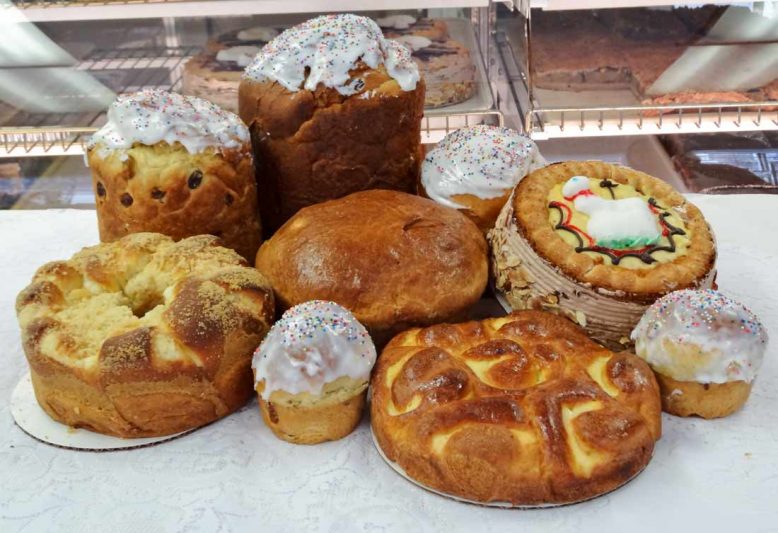
Actually, Polonia makes the babkas all year long, but the week before Easter, “We will be making quite a few–more than a thousand,” says owner Andrew Kaczmarek, 55.
The popular shop was opened by Kaczmarek’s 85-year-old father, John, in 1957. Andrew grew up there surrounded by the rich, sweet smells of his heritage. Their recipes have been around so long, he doesn’t know where they came from.
“Every Easter, I have worked morning until night,” he says, making babka and other traditional baked goods, like poppy seed cake and Paczki (punch-key), which is fried like a doughnut.
Many cultures across the globe have their own versions of leavened Easter bread, but generally they share a common trait. The weeks of sacrifice and abstinence of Lent leading up to the Christian spring holiday symbolize Jesus’ fast during his forty days in the desert. The rising of yeast dough is central to so many Easter feasts as a representation of his death and resurrection.
Babka is part of Jewish tradition as well, likely originating in Eastern Europe, the Ukraine or the Mediterranean. Jewish babka is loaf-shaped rather than round. It is made from rolled or twisted yeast dough filled with nuts, raisins and cinnamon or–an apparent American addition–chocolate. It is made all year.
Most of the holiday breads are characterized by the use of all the sweets, meats and dairy products that were traditionally prohibited during the Lenten observance. No matter where it originated, almost every Easter bread is rich and sugary, golden-hued from creamy butter and fresh eggs, and heavily laced with sugar, honey and often colorful candied fruits.
Babka, central to Eastern European celebrations, “is all butter, eggs and yolks,” says Kaczmarek.
Polonia’s babka begins with a sponge. This fermented mixture of yeast, water and flour starts the development of carbon dioxide gas that results in a generous rising of the dough when, after the addition of the dairy and more flour, it hits the heat of the oven.
Kaczmarek’s breads are filled with raisins, traditional ‘lekvar’ prune butter, or a sweetened cream cheese. Orders can be placed for 1, 2 or 3 pound loaves, starting at $5.75.
The plump babka is sometimes called baba, or grandmother, but legend has it that the name was coined three hundred years ago by an exiled Polish king who claimed that the Middle Eastern dried fruit studding the bread reminded him of the Arabian fictional character Ali-Baba.
Different Eastern European regions and countries have slight variations. When Russian Orthodox Easter comes in May, Kaczmarek will make a taller version with a white frosted cross on top sprinkled decoratively with colorful nonpareils.
After a lifetime of making babka, he knows that as sure as daffodils emerge from the ground each spring, his loaves will rise in time for the holiday, and there will be a long line waiting to gobble them up.
Polish Easter Babka
From about.com
Yields one 12-inch loaf
Ingredients:
• 1 cup milk
• 3 1/3 cups all-purpose flour
• 2 packages active dry yeast
• 1/4 cup lukewarm water
• 2/3 cup sugar
• 2 teaspoons salt
• 15 large egg yolks
• 1 teaspoon vanilla
• 1/4 teaspoon almond extract (optional)
• 1/2 cup melted butter
• 3/4 cup candied citrus rind (optional)
• 1/2 cup chopped almonds (optional)
• 1/3 cup light or dark raisins
Preparation:
1. Scald milk and pour into a large bowl or stand mixer bowl fitted with the paddle attachment. Add 3/4 cup of the flour, mixing well. Cool.
2. Dissolve yeast in lukewarm water 5 minutes. Add 1 tablespoon of the sugar and let stand 5 minutes. Add to cooled milk mixture, combining well. Cover and let rise until doubled.
3. In a separate large bowl, combine salt and egg yolks and beat until thick and lemon-colored, about 5 minutes. Add remaining sugar and extracts, mixing well. Combine egg mixture with risen milk mixture, beating thoroughly.
4. Add remaining flour and, using a wooden spoon, beat vigorously for 10 minutes or 7 minutes by machine with the paddle attachment. Add butter and continue to beat an additional 7-10 minutes. Beat in candied rind, almonds and raisins. Dough will be sticky. Scrape down sides, cover with greased plastic wrap and let rise until doubled in the same bowl. Punch down dough and let rise again until doubled.
5. Generously coat a 12-inch fluted babka pan or tube pan, or turk’s head mold (turban mold) with cooking spray. Punch down dough and, using slightly dampened hands, transfer to prepared pan. Cover and let rise 1 hour or until dough fills the pan. Heat oven to 350 degrees.
6. Bake about 50 minutes or until instant-read thermometer registers 190 degrees or toothpick comes out clean. Cool in pan 10 minutes and invert onto rack to cool completely. Leave plain or dust with confectioners’ sugar, if desired.
SUZANNE ZIMMER LOWERY is a food writer, pastry chef and culinary instructor at a number of New Jersey cooking schools. Find out more about her at suzannelowery.com.


As a child, part of my family’s Sunday routine after church was a trip to Polonia bakery. We bought our bread (“A loaf of rye, no seeds, sliced”) for the week and always some cake, cookie or treat. A few years ago I was back in Passaic for a visit and went to look up Polonia bakery. What a wave of memory and nostalgia! The lay-out was exactly as I remembered it complete with the baked goods of my youth. I loaded up on everything to bring home and share. What a wonderful bakery and legacy! Great article!